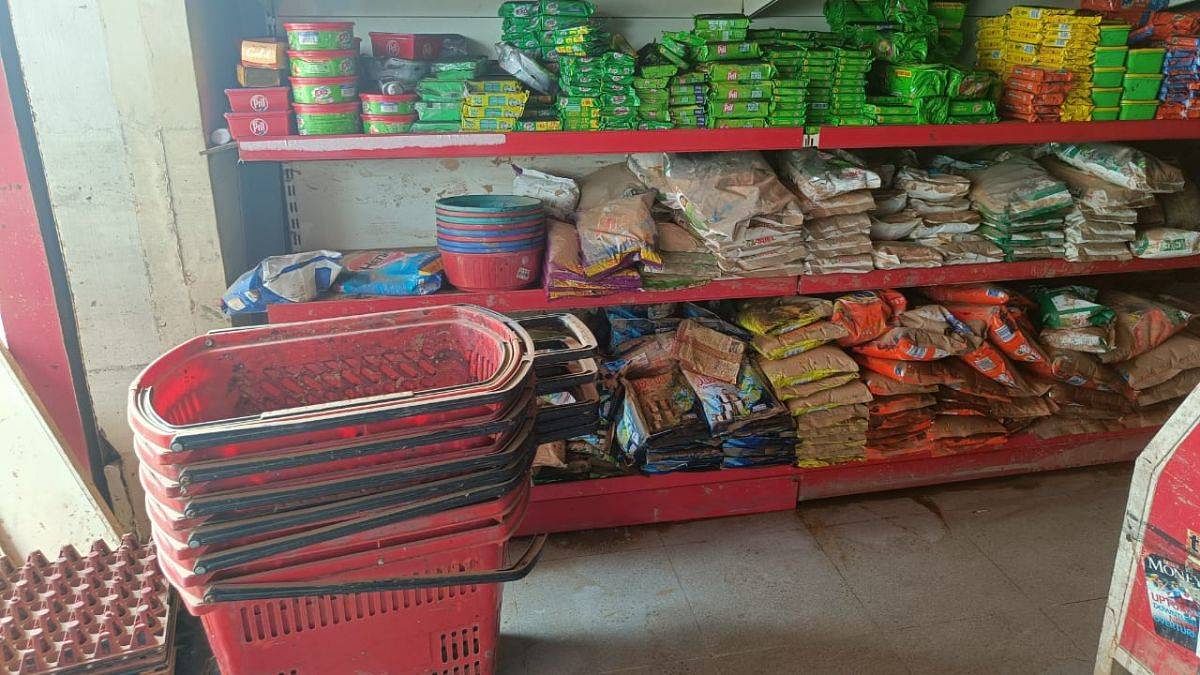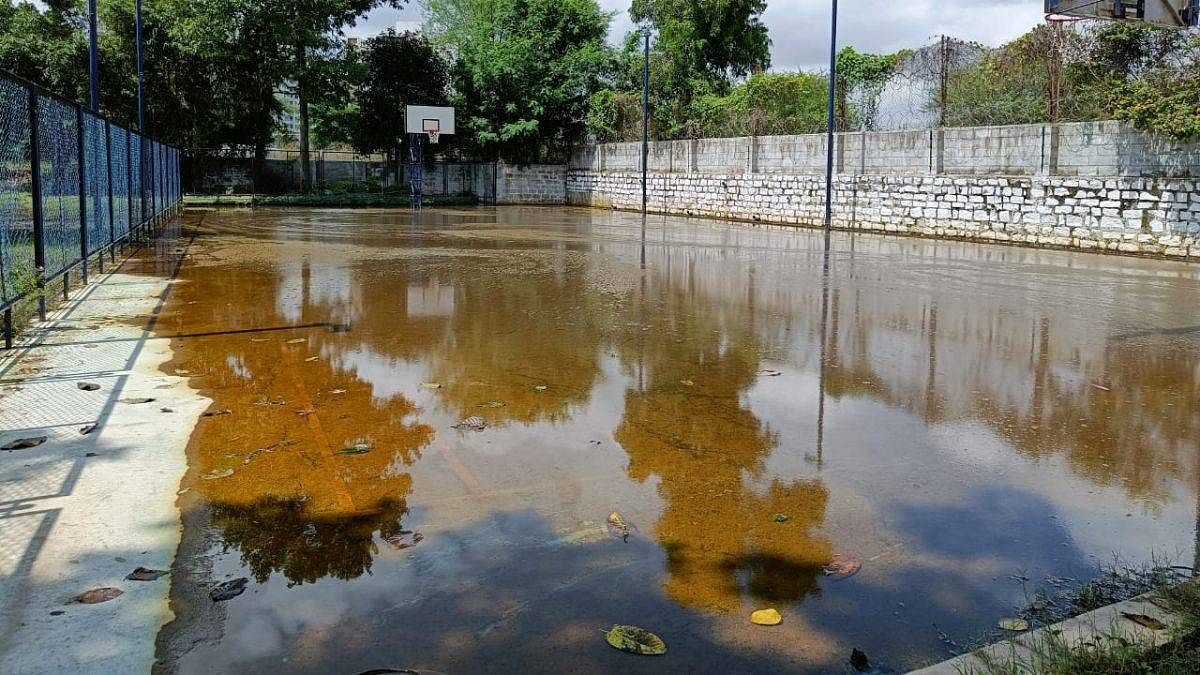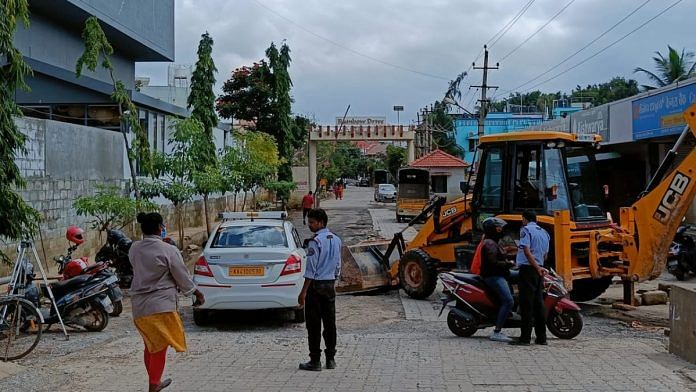Bengaluru: The marks made by floodwaters on the walls of Aishwarya Departmental Store, located at the entrance of Bengaluru’s Rainbow Drive Layout, could be seen clearly. Sameer, owner of the grocery store, sat on a small stool, supervising his staff. Hands covered in rubber gloves, they sorted the goods wrecked by last week’s floods.
“Take the daal out of the packet, dry it out a bit and repack it. It should be okay,” he instructed a vendor, who was buying from his supermarket to sell elsewhere. The packets of pulses, stocked on a high shelf, had escaped being soaked by the waist-deep waters that flooded the store, leaving Sameer, who has run the store for 15 years, with a massive bill. All the refrigerators in his store blew up, covering the ceiling in soot.

Rainbow Drive, a gated community on Sarjapur Road near Halanayakanahalli lake, was constructed almost 25 years ago and has nearly 300 houses.
In a circular issued Monday, dated August 2022, the Bruhat Bengaluru Mahanagara Palike (BBMP) named 15 encroachments allegedly done by IT parks and developers in the Mahadevapura constituency. Some houses in Rainbow Drive figured on the list.
Reacting to the circular, water activist and Bellandur resident Nagesh Aras told ThePrint: “Any such statements in the wake of public outroar must be taken with a pinch of salt. When cornered, the BBMP typically looks for a soft target and makes it a scapegoat. Afterwards, nothing happens. No one acts till the next disaster, but when it does occur, they repeat the same blame game again.”
On 5 September, Rainbow Drive was flooded, affecting 20-25 houses located in a low-lying area and leaving some residents marooned for hours without even drinking water. From 10 inches, the water rose to five feet, the residents claimed.
“People are making up stories that we are built on a lake,” a disgruntled resident, who works with an IT company nearby and did not wish to be named, told ThePrint. “It is convenient to blame the ‘outsider’ [those coming in from outside Karnataka to work in the state]. This has become about the haves and have nots, people are riding the opportunity to blame us,” he said.
The residents of Rainbow Drive claim to live in a very “environmentally-conscious community”. In 2020, the community was praised for its rainwater harvesting efforts and recycling of used water.
It wasn’t too long before the issue around the floods took a political turn. Speaking to the media on 9 September, BJP MP for Bengaluru South, Tejasvi Surya, said it was the Congress and a “certain section” of people with “vested interests” who were giving the wrong impression of the whole city being flooded. “This is a conspiracy to defame Bangalore, a conspiracy to defame our government,” he said.
Meanwhile Chief Minister Basavaraj Bommai, blaming the previous Congress government for not checking encroachments, said there will be no partisanship shown in the drive to remove the alleged encroachment of stormwater drains believed to be the major reasons for the floods.
BBMP Monday initiated an anti-encroachment offensive in eight places which they believed was causing flooding in and around Bellandur in Mahadevapura zone. The previous day, the Bengaluru East tahsildar had issued notices to 13 residents of the gated community for alleged encroachment of a stormwater drain.
According to reports, the authorities alleged the residents’ properties blocked major areas of the culvert, making the layout prone to flooding during rains. In the first week of August, residents said they had taken to the streets in protest against the civic authorities’ apathy for not fixing issues that lead to floods.
“Behind the layout are redeveloped villages which are on higher ground and their water and sewage rolls down towards Rainbow Drive. When people build up an area which doesn’t allow traffic, sewage or water, then you have a problem. The people who live behind the layout will have to take a major detour to get to the main road, but water and sewage won’t wait for anyone. It will simply enter low lying areas,” said water activist Aras.
Also read: Wet mattresses, smelly rice, rain fear — Bengaluru East struggles to recover from freak flood
A concrete jungle
Rainbow Drive, as evident from the elevation map, is in a valley area, connecting the lakes of Halanayakanahalli and Junnasandra, downstream to Saul Kere.
Before the civic body got to it with its anti-encroachment drive, the floodwaters appeared to have destroyed parts of the compound wall behind the Rainbow Drive Club House. When ThePrint visited the spot, the tennis and basketball courts were filled with stagnant sewage water. As was the swimming pool.

On the main road that runs through the layout, a BBMP staff member was supervising a fleet of 30 sanitation workers. “We have worked here for three to four days straight, trying to clean up the muck from the floodwaters,” he said. “People are upset and angry.”
Nearly all the Rainbow Drive residents ThePrint spoke to requested anonymity, afraid there may be some backlash from local authorities. Some residents also alleged the blame game was initiated by powerful developers who wanted to drive a road through the layout to link their properties to the main road.
A long-time resident of the community told ThePrint that when her family moved into the property in the 1990s, there was barely any built up area around. Now, the compound wall at the entrance overlooks tall buildings housing a popular clothing brand and a restaurant chain. “It is only in the past decade that this whole Sarjapur area has turned into a concrete jungle,” she said.
She urged ThePrint to look at satellite images to see the difference. “You will find that a lot of the area around here was agricultural land,” she said.
Aras told ThePrint that Rainbow Drive was developed in three construction phases. “One belongs to the BBMP, the other two phases to two separate villages. Both these villages come under the zila parishad and there is no coordination with the BBMP,” he said, adding that there is no coordinated planning for a water system or proper sewage management. “The layout slopes towards the parts governed by the BBMP and the sewage and rainwater from the villages roll down to the BBMP area,” he said.
He added that trying to build a drainage or sewerage system here would be difficult since the area is now fully built.
Another factor, said Aras, is rampant encroachment of ‘B Kharab’ land (non-cultivable land belonging to the government), which can be used for building infrastructure. “But corrupt officers just let it go in private hands, and even regularise the encroachment. This robs the city of vital infrastructure. In the case of Rainbow Drive, BBMP’s hand was forced by the floods. Now it wants to recover this land by demolishing the houses,” he said.
Also read: Bengaluru flooding will reveal how water can send your flashy, high-end car to scrapyard
The divide
Much like Rainbow Drive, which was entirely inundated, upmarket areas of DivyaSree 77 and Epsilon Residential Villas — home to some of Bengaluru’s tech CEOs — were also equally affected last week. However, ThePrint wasn’t allowed to enter either property. “There was minor waterlogging, now that issue is resolved,” A security guard at Epsilon told ThePrint.
Houses in Epsilon also featured on BBMP’s circular naming alleged encroachers.
Away from richer neighbourhoods, Moya Caddy, a resident of Bengaluru for 14 years has, along with her friends, been helping residents of slum areas affected by the floods. The team has been providing rice, daal, atta, oil, tea and sugar to slum dwellers in Dasarahalli, Veerannapalya and Bellahalli. Over the next few days, it plans to visit settlements in Varthur and Whitefield.
“Many of these areas are migrant camps,” Caddy told ThePrint. These migrant workers, she said, are the ones who service the city’s burgeoning population, working as maids, drivers or watchmen. “After visiting these slums, we realised the government is not doing enough. The poor are suffering and the public needs to step up and do something.”
(Edited by Zinnia Ray Chaudhuri)
Also read: Heavy rain, poor drainage, worse infra — how Bengaluru was hit by a perfect storm and drowned






